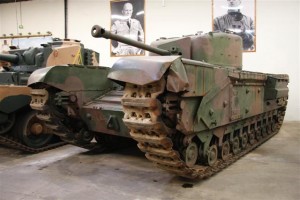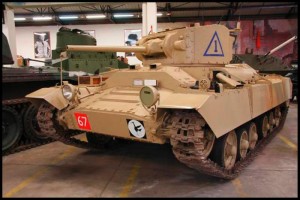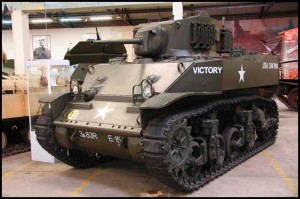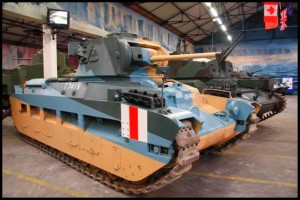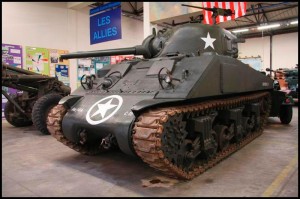Room Allied World War II
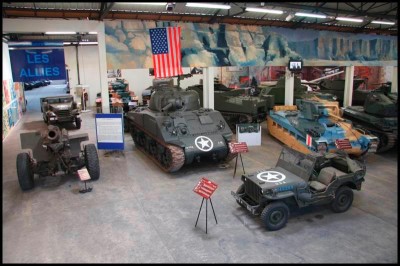
The first Allied tanks present in France, as of September 1939, were the Matilda tanks and the Vickers chenilletes of the British Expeditionary Force, who came to support the French troops in the north. Other units of the Royal Tank Corps, equipped with light tanks Matilda II and Covenanter, All these troops will courageously fight, during the counter-attack of Abbeville in particular, despite the weaknesses of their equipment, little armored and only weapons of 40 mm guns.
The Dieppe suicide operation (Spring 1942), where Canadian troops will be sacrificed to withdraw lessons from a landing attempt, will see the first commitment of the new Churchill tank, from which will be derived a whole family of special machines or "funnies": bearer of fascines to fill the pits; "Crocodile": equipped with a flamethrower and a trailer for incendiary frost; anemones with a chains of hammers hammering the ground. . .
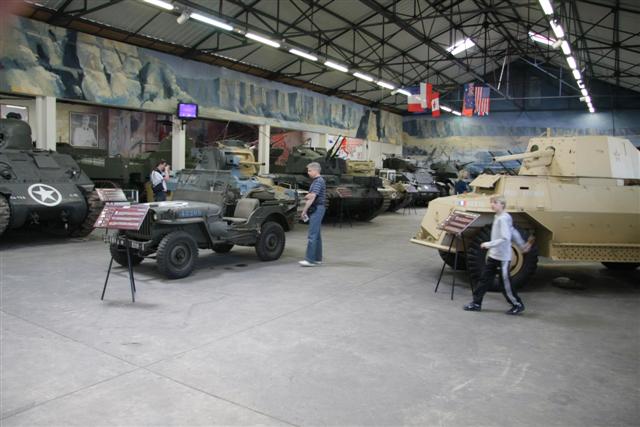
Then comes the Valentine, whose exemplary 10 000s will concern various versions, and which will equip the French Army of Africa, during the fighting of Tunisia. All these blinds will fight effectively against the Italian blinds in Cyrenaica, but the least that can be said is that they will not make the weight against Marshal Rommel's Panzer.
Fortunately, massive American reinforcements arrive in Egypt and it is with no pleasure that the "Desert Rat" discovers the new Grant and Sherman during the battle of EI Alamein, in the autumn 1942. It's sort of a baptism of fire for the American blinds.
In the inter-war period, the United States showed no interest in tanks, which were of no use. Their only experience in this field was that of General Patton during the First World War. Formed at the Cavalry School of Saumur, he created in the east of France the first school of blinds US with Renault FT and will participate in the attack of Saint-Mihiel.
Some gear you'll come across in the room Allies World War II:
- M4 Sherman
- Jeep
- KV 1
- AM M8 Greyhound
- T34 / 76
- Matilda II
- Churchill Mk.V
And many others ...
machinery
-
The Churchill
If one should not expect aesthetic miracles from a tank, the silhouette of the Churchill still has something to surprise, with its lines carved with a bill hook, its immense tracks, its almost cylindrical turret of 'where a thin cannon comes out. Yet the 540 examples of these tanks, produced in different versions, proved to be very effective, on all fronts ... -
The Valentine Mark III tank
The project file for a new infantry support tank was proposed to the British War Office in 1938, on Valentine's Day. He was therefore baptized Valentine! Like all British tanks of this period, it was not an extraordinary machine although 3700 units of several versions were built. The free French ... -
The Stuart tank
If its name suggests a British origin, the Stuartest makes it an American 13-ton light tank which reached its heyday during the two battles of El Alamein, in June and October 1942. However, with its 30 mm gun, these 7,62 mm machine guns and 38 mm armor, this small machine, of little weight compared to the Panzer III and IV of Rommel, could play an effective role ... -
the Matilda MK I and II tank
It was a fashionable song across the Channel in 1940: "Walzing Matilda", extrapolated from the bag that swayed on the hips of English railway workers when they walked. And, since these tanks had a very soft suspension, they were named Matilda! Another legend has it that this tank was called Matilda by Australian troops arriving in Egypt in 1942: The ... -
The M4 Sherman tank
For the French, the Sherman tank is the mythical tank of the liberation, especially since it equipped the Leclerc Division when it entered Paris. The general opinion was, however, that it was not a very good machine. Lightly armored (12 to 76 mm), poorly armed (1 gun of 75 and 2 machine guns), slow (40 km / h), the M4 was in all points inferior to the German tanks. But the number (more than ... -
The tank T 34-76
We can say of this tank that it traumatized the Germans when it appeared during the counter-offensives of the winter of 1941-1942, in front of Moscow. Studied according to the specialties of the climate and the Russian topography, it passed at ease in the snow and the mud where the Panzers stuck. Its diesel engine started at a quarter-turn while the Werhmacht consumed a precious ...

